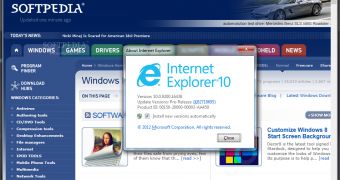Internet Explorer 10 is the first version of Microsoft’s in-house browser that comes with a built-in copy of Flash Player, thus trying to make sure that users are provided with security updates as soon as they are released.
Adobe’s Peleus Uhley, platform security strategist, explains today that this integration has many more benefits, especially when it comes to security.
Patches are now distributed via Windows Update, so those still running Internet Explorer 10 can be sure that they have the latest version of the Flash Player.
While Windows 7 users continue to be provided with Flash Player updates through the old mechanism, Windows 8 adopters get the same improvements on Patch Tuesday without any interaction, with all updates automatically installed just like all the other fixes released by Microsoft.
In addition, Windows 8 and Internet Explorer 10 offer what it’s being called “Enhanced Protected Mode” (EPM), a brand new feature that’s enabled by default in immersive mode.
“EPM on IE 10 provides several new protections. One is that all content processes will run as 64-bit processes. This means that Flash Player will also be run as a 64-bit process which will make heap sprays more difficult. The larger address space makes it more difficult to predict the memory location of the spray with a decent statistical likelihood,” Uhley notes.
“The Windows 8 OS security model also utilizes AppContainers for Windows Store. The AppContainer for Internet Explorer 10 is an improvement on the existing idea of Integrity levels. The IE 10 AppContainer brokers both read and write access to most of the operating system,” he continues.
The collaboration between Microsoft and Adobe, on the other hand, is essential when it comes to delivering the latest patches to Windows 8 users, but both companies have promised to work together for a streamlined update workflow.

 14 DAY TRIAL //
14 DAY TRIAL //